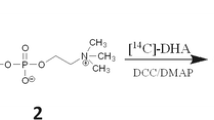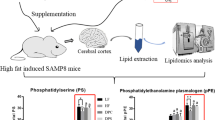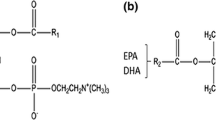Abstract
Fatty acids have many health benefits in a great variety of diseases ranging from cardiovascular to cerebral diseases. For instance, docosahexaenoic acid (DHA), which is highly enriched in brain phospholipids, plays a major role in anti-inflammatory or neuroprotective pathways. Its effects are thought to be due, in part, to its conversion into derived mediators such as protectins. 1-Lyso,2-docosahexaenoyl-glycerophosphocholine (LysoPtdCho-DHA) is one of the physiological carrier of DHA to the brain. We previously synthesized a structured phosphatidylcholine to mimic 1-lyso,2-docosahexaenoyl-glycerophosphocholine, named AceDoPC® (1-acetyl,2-docosahexaenoyl-glycerophosphocholine), that is considered as a stabilized form of the physiological LysoPtdCho-DHA and that is neuroprotective in experimental ischemic stroke. Considering these, the current study aimed at enzymatically oxygenate DHA contained within AceDoPC® to synthesize a readily structured oxidized phospholipid containing protectin DX (PDX), thereafter named AceDoxyPC (1-acetyl,2-PDX-glycerophosphocholine). Identification of this product was performed using liquid chromatography/tandem mass spectrometry. Such molecule could be used as a bioactive mediator for therapy against neurodegenerative diseases and stroke.







Similar content being viewed by others
Abbreviations
- AceDoPC:
-
1-Acetyl,2-DHA-glycerophosphocholine
- AceDoxyPC:
-
1-Acetyl,2-PDX-glycerophosphocholine
- BBB:
-
Blood–brain barrier
- CID:
-
Collision-induced dissociation
- DCC:
-
1,3-Dicyclohexylcarbodiimide
- DMAP:
-
4-(Dimethylamino)pyridine
- DMF:
-
Dimethylformamide
- GPC:
-
sn-Glycerophosphocholine
- LOX:
-
Lipoxygenase
- LysoPtdCho-DHA:
-
1-Lyso,2-docosahexaenoyl-glycerophosphocholine
- MRM:
-
Multiple reaction monitoring
- PD1:
-
Protectin D1
- PDX:
-
Protectin DX
- sLOX:
-
Soybean lipoxygenase
References
Thies F, Pillon C, Moliere P, Lagarde M, Lecerf J (1994) Preferential incorporation of sn-2 lysoPC DHA over unesterified DHA in the young rat brain. Am J Physiol 267:R1273–R1279
Bernoud N, Fenart L, Molière P, Dehouck MP, Lagarde M, Cecchelli R, Lecerf J (1999) Preferential transfer of 2-docosahexaenoyl-1-lysophosphatidylcholine through an in vitro blood–brain barrier over unesterified docosahexaenoic acid. J Neurochem 72:338–345
Chen CT, Kitson AP, Hopperton KE, Domenichiello AF, Trépanier MO, Lin LE, Ermini L, Post M, Thies F, Bazinet RP (2015) Plasma non-esterified docosahexaenoic acid is the major pool supplying the brain. Sci Rep 5:15791
Brossard N, Croset M, Lecerf J, Pachiaudi C, Normand S, Chirouze V, Macovschi O, Riou JP, Tayot JL, Lagarde M (1996) Metabolic fate of an oral tracer dose of [13C]docosahexaenoic acid triglycerides in the rat. Am J Physiol 270:R846–R854
Brossard N, Croset M, Normand S, Pousin J, Lecerf J, Laville M, Tayot JL, Lagarde M (1997) Human plasma albumin transports [13C]docosahexaenoic acid in two lipid forms to blood cells. J Lipid Res 7:1571–1582
Nguyen NL, Ma D, Shui G, Wong P, Cazenave-Gassiot A, Zhang X, Wenk MR, Goh ELK, Silver DL (2014) Mfsd2a is a transporter for the essential omega-3 fatty acid docosahexaenoic acid. Nature 509:503–506
Quek DQY, Nguyen LN, Fan H, Silver DL (2016) Structural insights into the transport mechanism of the human sodium-dependent lysophosphatidylcholine transporter MFSD2A. J Biol Chem 291:9383–9394
Wong BH, Chan JP, Cazenave-Gassiot A, Poh RW, Foo JC, Galam DL, Ghosh S, Nguyen LN, Barathi VA, Yeo SW, Luu CD, Wenk MR, Silver DL (2016) Mfsd2a is a transporter for the essential ω-3 fatty acid docosahexaenoic acid (DHA) in eye and is important for photoreceptor cell development. J Biol Chem 291:10501–10514
Angers M, Uldry M, Kong D, Gimble JM, Jetten AM (2008) Mfsd2a encodes a novel major facilitator superfamily domain-containing protein highly induced in brown adipose tissue during fasting and adaptive thermogenesis. Biochem J 416:347–355
Croset M, Brossard N, Polette A, Lagarde M (2000) Characterization of plasma unsaturated lysophosphatidylcholines in human and rat. Biochem J 345:61–67
Polette A, Deshayes C, Chantegrel B, Croset M, Armstrong JM, Lagarde M (1999) Synthesis of acetyl, docosahexaenoyl-glycerophosphocholine and its characterization using nuclear magnetic resonance. Lipids 34:1333–1337
Lagarde M, Hachem M, Bernoud-Hubac N, Picq M, Véricel E, Guichardant M (2015) Biological properties of a DHA-containing structured phospholipid (AceDoPC) to target the brain. Prostaglandins Leukot Essent Fat Acids 92:63–65
Hachem M, Géloën A, Lo Van A, Fourmaux B, Fenart L, Gosselet F, Da Silva P, Breton G, Lagarde M, Picq M, Bernoud-Hubac N (2016) Efficient docosahexaenoic acid uptake by the brain from a structured phospholipid. Mol Neurobiol 53:3205–3215
Chauveau F, Cho T-H, Perez M, Guichardant M, Riou A, Aguettaz P, Picq M, Lagarde M, Berthezène Y, Nighoghossian N, Wiart M (2011) Brain-targeting form of docosahexaenoic acid for experimental stroke treatment: MRI evaluation and anti-oxidant impact. Curr Neurovasc Res 8:95–102
Lo Van A, Sakayori N, Hachem M, Belkouch M, Picq M, Lagarde M, Osumi N, Bernoud-Hubac N (2016) Mechanisms of DHA transport to the brain and potential therapy to neurodegenerative diseases. Biochimie 130:163–167
Belkouch M, Hachem M, Elgot A, Lo A, Picq M, Guichardant M, Lagarde M, Bernoud-Hubac N (2016) The pleiotropic effects of omega-3 docosahexaenoic acid on the hallmarks of Alzheimer’s disease. J Nutr Biochem 38:1–11
Serhan CN (2005) Mediator lipidomics. Prostaglandins Other Lipid Mediat 77:4–14
Gonzalez-Periz A, Horrillo R, Ferre N, Gronert K, Dong B, Moran-Salvador E, Titos E, Martinez-Clemente M, Lopez-Parra M, Arroyo V, Claria J (2009) Obesity-induced insulin resistance and hepatic steatosis are alleviated by omega-3 fatty acids: a role for resolvins and protectins. FASEB J 23:1946–1957
Aveldano MI, Sprecher H (1983) Synthesis of hydroxy fatty acids from 4,7,10,13,16,19-[1-14C] docosahexaenoic acid by human platelets. J Biol Chem 25:9339–9343
Miller C, Yamaguchi RY, Ziboh VA (1989) Guinea pig epidermis generates putative anti-inflammatory metabolites from fish oil polyunsaturated fatty acids. Lipids 24:998–1003
Kim HY, Karanian JW, Salem NJ (1990) Formation of 15-lipoxygenase product from docosahexaenoic acid (22:6w3) by human platelets. Prostaglandins 40:539–549
Chen P, Fenet B, Michaud S, Tomczyk N, Véricel E, Lagarde M, Guichardant M (2009) Full characterization of PDX, a neuroprotectin/protectin D1 isomer, which inhibits blood platelet aggregation. FEBS Lett 583:3478–3484
Balas L, Guichardant M, Durand T, Lagarde M (2014) Confusion between protectin D1 (PD1) and its isomer protectin DX (PDX). An overview on the dihydroxy-docosatrienes described to date. Biochimie 99:1–7
Chen P, Véricel E, Lagarde M, Guichardant M (2011) Poxytrins, a class of oxygenated products from polyunsaturated fatty acids, potently inhibit blood platelet aggregation. FASEB J 25:382–388
Huang LS, Hung ND, Sok DE, Kim MR (2010) Lysophosphatidylcholine containing docosahexaenoic acid at the sn-1 position is anti-inflammatory. Lipids 45:225–236
Bochkov VN, Kadl A, Huber J, Gruber F, Binder BR, Leitinger N (2002) Protective role of phospholipid oxidation products in endotoxin-induced tissue damage. Lett Nat 4:77–81
Leitinger N, Tyner TR, Oslund L, Rizza C, Subbanagounder G, Lee H, Shih PT, Mackman N, Tigyi G, Territo MC, Berliner JA, Vora DK (1999) Structurally similar oxidized phospholipids differentially regulate endothelial binding of monocytes and neutrophils. Proc Natl Acad Sci USA 96:12010–12015
Murray JJ, Brash AR (1988) Rabbit reticulocyte lipoxygenase catalyzes specific 12(S) and 15(S) oxygenation of arachidonoyl-phosphatidylcholine. Arch Biochem Biophys 265:514–523
Takahashi Y, Glasgow WC, Suzuki H, Taketani Y, Yamamoto S, Anton M, Kühn H, Brash AR (1993) Investigation of the oxygenation of phospholipids by the porcine leukocyte and human platelet arachidonate 12-lipoxygenases. Eur J Biochem 218:165–171
Maccarrone M, van Aarle PGM, Veldink GA, Vliegenthart JFG (1994) In vitro oxygenation of soybean biomembranes by lipoxygenase-2. BBA Biomembr 1190:164–169
Huang LS, Kim MR, Sok D-E (2007) Oxygenation of 1-docosahexaenoyl lysophosphatidylcholine by lipoxygenases; conjugated hydroperoxydiene and dihydroxytriene derivatives. Lipids 42:981–990
Bochkov VN, Oskolkova OV, Birukov KG, Levonen AL, Binder CJ, Stöckl J (2010) Generation and biological activities of oxidized phospholipids. Antioxid Redox Signal 12:1009–1059
Ashraf MZ, Srivastava S (2012) Oxidized phospholipids: introduction and biological significance. In: Frank S, Kostner G (eds) Lipoproteins – role health disease. InTech, Rijeka, pp 409–430
Butovich IA, Lukyanova SM, Bachmann C (2006) Dihydroxydocosahexaenoic acids of the neuroprotectin D family: synthesis, structure, and inhibition of human 5-lipoxygenase. J Lipid Res 47:2462–2474
Acknowledgements
This study was supported by Lisa CARNOT Institute, National Institute of Applied Sciences-Lyon and the French Ministry of Education and Research. We thank Laurence Daniel and Valentin Ramel for their technical and supportive assistance.
Author information
Authors and Affiliations
Corresponding author
Ethics declarations
Conflict of interest
Pending patent: WO 2017006047 A1. NBH, MP, MG, and ML are associates in LipTher (http://www.lipther.com/), an emerging start up from the academic CarMeN laboratory, INSA-Lyon, whose objective is to produce AceDoPC® on a large scale.
About this article
Cite this article
Lo Van, A., Fourmaux, B., Picq, M. et al. Synthesis and Identification of AceDoxyPC, a Protectin-Containing Structured Phospholipid, Using Liquid Chromatography/Mass Spectrometry. Lipids 52, 751–761 (2017). https://doi.org/10.1007/s11745-017-4280-z
Received:
Accepted:
Published:
Issue Date:
DOI: https://doi.org/10.1007/s11745-017-4280-z




